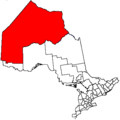Slate Falls | |
|---|---|
| Slate Falls Indian Settlement | |
| Coordinates: 51°10′N91°35′W / 51.167°N 91.583°W | |
| Country | |
| Province | |
| District | Kenora |
| First Nation | Slate Falls |
| Area | |
| • Land | 8.75 km2 (3.38 sq mi) |
| Population (2011) [1] | |
• Total | 186 |
| • Density | 21.3/km2 (55/sq mi) |
Slate Falls Nation (Ojibwe : Shakopaatikoong) [2] is an Ojibwe First Nation band government in Ontario. It has a settlement at Slate Falls in Kenora District, Ontario. As of 2016, the First Nation had a registered population of 241 people, of which the on-reserve population was 9. [3]

